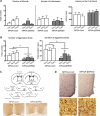Effects of Prepubertal or Adult Site-Specific Knockdown of Estrogen Receptor β in the Medial Preoptic Area and Medial Amygdala on Social Behaviors in Male Mice
- PMID: 27066533
- PMCID: PMC4819287
- DOI: 10.1523/ENEURO.0155-15.2016
Effects of Prepubertal or Adult Site-Specific Knockdown of Estrogen Receptor β in the Medial Preoptic Area and Medial Amygdala on Social Behaviors in Male Mice
Abstract
Testosterone, after being converted to estradiol in the brain, acts on estrogen receptors (ERα and ERβ) and controls the expression of male-type social behavior. Previous studies in male mice have revealed that ERα expressed in the medial preoptic area (MPOA) and medial amygdala (MeA) are differently involved in the regulation of sexual and aggressive behaviors by testosterone action at the time of testing in adult and/or on brain masculinization process during pubertal period. However, a role played by ERβ in these brain regions still remains unclear. Here we examined the effects of site-specific knockdown of ERβ (βERKD) in the MPOA and MeA on male social behaviors with the use of adeno-associated viral mediated RNA interference methods in ICR/Jcl mice. Prepubertal βERKD in the MPOA revealed that continuous suppression of ERβ gene expression throughout the pubertal period and adulthood decreased aggressive but not sexual behavior tested as adults. Because βERKD in the MPOA only in adulthood did not affect either sexual or aggressive behaviors, it was concluded that pubertal ERβ in the MPOA might have an essential role for the full expression of aggressive behavior in adulthood. On the other hand, although neither prepubertal nor adult βERKD in the MeA had any effects on sexual and aggressive behavior, βERKD in adulthood disrupted sexual preference of receptive females over nonreceptive females. Collectively, these results suggest that ERβ in the MPOA and MeA are involved in the regulation of male sexual and aggressive behavior in a manner substantially different from that of ERα.
Keywords: aggressive behavior; estrogen receptor β; medial amygdale; medial preoptic area; sexual preference; site-specific knockdown.
Conflict of interest statement
The authors report no conflict of interest.
Figures





References
-
- Coolen LM, Peters HJ, Veening JG (1997) Distribution of Fos immunoreactivity following mating versus anogenital investigation in the male rat brain. Neuroscience 77:1151–1161. - PubMed
Publication types
MeSH terms
Substances
LinkOut - more resources
Full Text Sources
Other Literature Sources
